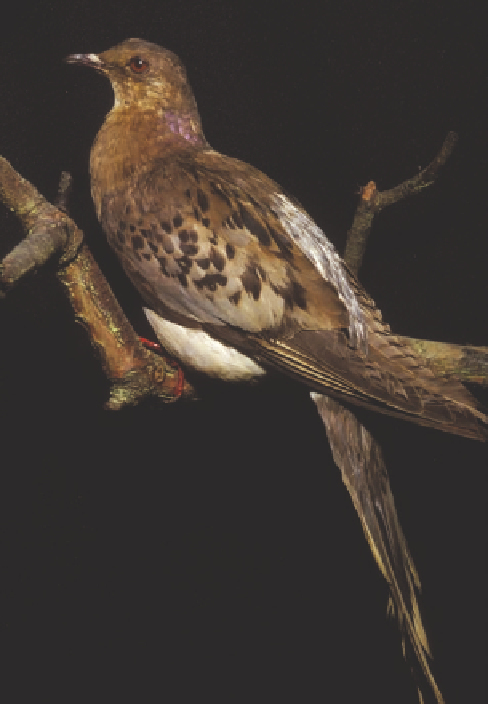Environmental Engineering Reference
In-Depth Information
9
Population
Control
Sustaining Biodiversity:
The Species Approach
Biodiversity
CASE STUDY
The Passenger Pigeon:
Gone Forever
(after Martha Washington), died in the Cincinnati
Zoo in 1914. Her stuffed body is now on view
at the National Museum of Natural History in
Washington, D.C.
Eventually all species become extinct or evolve
into new species. Biologists estimate that every day
2-200 species become prematurely extinct primarily
because of human activities. This rate of loss of biodi-
versity is expected to increase as the human popula-
tion grows, consumes more resources, disturbs more
of the earth's land and aquatic systems, and uses more
of the earth's net primary productivity that supports
all species.
In 1813, bird expert John James Audubon saw a single
flock of passenger pigeons that he estimated was 16
kilometers (10 miles) wide and hundreds of kilome-
ters long, and contained perhaps a billion birds. The
flock took three days to fly past him and was so dense
that it darkened the skies.
By 1914, the passenger pigeon (Figure 9-1) had
disappeared forever. How could a species that was
once the most common bird in North America (and
probably the world) become extinct in only a few
decades? Humans wiped them out. The extinction of
this species largely resulted from uncontrolled com-
mercial hunting and loss of the bird's habitat and food
supply as forests were cleared to make room for farms
and cities.
Passenger pigeons were good to eat, their feathers
made good filling for pillows, and their bones were
widely used for fertilizer. They were easy to kill be-
cause they flew in gigantic flocks and nested in long,
narrow colonies.
Commercial hunters would capture one pigeon
alive, sew its eyes shut, and tie it to a perch called a
stool. Soon a curious flock would land beside this
“stool pigeon”—a term we now use to describe some-
one who turns in another person for breaking the law.
Then the birds would be shot or ensnared by nets that
might trap more than 1,000 birds at once.
Beginning in 1858, passenger pigeon hunting
became a big business. Shotguns, traps, artillery, and
even dynamite were used. People burned grass or sul-
fur below their roosts to suffocate the birds. Shooting
galleries used live birds as targets. In 1878, one profes-
sional pigeon trapper made $60,000 by killing 3 mil-
lion birds at their nesting grounds near Petoskey,
Michigan!
By the early 1880s, only a few thousand birds
remained. At that point, recovery of the species was
doomed because the females laid only one egg per
nest each year. On March 24, 1900, a young boy in
Ohio shot the last known wild passenger pigeon. The
last passenger pigeon on earth, a hen named Martha
Figure 9-1
Lost natural capital:
passenger pigeons have
been extinct in the wild since 1900. The last known passenger
pigeon died in the Cincinnati Zoo in 1914.



